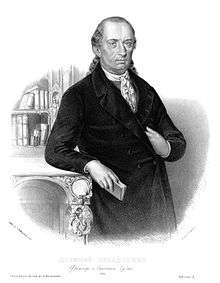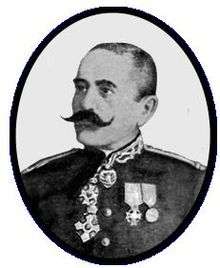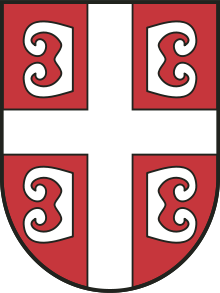Serbs of Romania
| Total population | |
|---|---|
| (18,076 (2011)) | |
| Regions with significant populations | |
| Banat | |
| Languages | |
| Serbian and Romanian | |
| Religion | |
| Eastern Orthodoxy (Serbian Church) | |
| Related ethnic groups | |
| Croats of Romania |
The Serbs of Romania (Romanian: Sârbii din România, Serbian: Срби у Румунији/Srbi u Rumiji) are a recognized ethnic minority numbering 18,076 people (0.1%) according to the 2011 census. The community is concentrated in western Romania, in the Romanian part of the Banat region (divided with Serbia), where they constitute absolute majority in two communes and relative majority in one other.
History
Historical background
Slavic presence is attested in Romania since the Early Middle Ages. The Avar Khaganate was the dominant power of the Carpathian Basin between around 567 and 803.[1] Most historians agree that Slavs and Bulgars, together with the remnants of the Avars, and possibly with Vlachs (or Romanians), inhabited the Banat region after the fall of the khaganate.[2] Place names of Slavic origin recorded already in the Middle Ages show the early presence of a Slavic-speaking population.[3]
Early modern period
From the late 14th- to the beginning of the 16th century a large number of Serbs lived in Wallachia and Moldavia.[4] Following Ottoman expansion in the 15th century, Serb mass migrations ensued into Pannonia.[4] Serbian Orthodox monasteries began to be built in the area from the 15th century, including Kusić and Senđurađ built by despot Jovan Branković, and in the 16th century including Bezdin and Hodoš built by the Jakšić family.[4] In the Ottoman period, some thirty Serbian Orthodox monasteries were built in the territory of Romania.[4]
Ottoman pressure traditionally forced members of several South Slavic communities to seek refuge in Wallachia - although under Ottoman rule as well, the latter was always subject to less requirements than regions to south of the Danube.
The Serbian Uprising in Banat (1594) included territories part of modern Romania. There were reprisals, contemporary sources speaking of "the living envied the dead".[5] After the crushing of the uprising in Banat, many Serbs migrated to Transylvania under the leadership of Bishop Teodor; the territory towards Ineu and Teiuș was settled, where Serbs had lived since earlier – the Serbs had their eparchies, opened schools, founded churches and printing houses.[5]
Serbs-proper probably constituted the vast majority of mercenary troops known as seimeni, given that their nucleus is attested to have been formed by "Serb seimeni" (as it was during their revolt in 1655), and that the rule of Prince Matei Basarab had witnessed the arrival of a large group of Serb refugees.
The Great Migrations of the Serbs in 1690 and 1737–39 led to additional settlement of Serbs.
Modern
These groups are, however, hard to distinguish one from another in early Wallachian references, as the term "Serbs" is regularly applied to all Southern Slavs, no matter where they might have originated. This only changed in the 19th century, through a transition made clear by an official statistic of 1830, which reads "census of how many Serbs are resident here in the town of Ploiești, all of them Bulgarians" (Giurescu, p. 269).
The Bărăgan deportations (1951–56) saw minorities (including Serbs) from the Banat region bordering Yugoslavia deported to south-eastern Romania due to the deteriorating Yugoslav–USSR relations and the perceived "elements who present a danger through their presence in the area" to the Romanian Communist regime.[6]
Demographics
According to the 2011 census, there was 18,076 people of the Serb minority,[7] down from 22,561 people in 2002.
In Caraș-Severin County, the Serbs constitute an absolute majority in the commune of Pojejena (52.09%)[8] and a plurality in the commune of Socol (49.54%).[9] Serbs also constitute absolute majority in the municipality of Svinița (87.27%) in the Mehedinți County.[10] The region where these three municipalities are located is known as Clisura Dunării in Romanian or Banatska Klisura (Банатска Клисура) in Serbian.
Localities
The following localities had a Serb population greater than 1% according to the 2011 census. Serbian placenames are included in brackets.
- Arad County
- Caraș-Severin County
- Mehedinți County
- Svinița (Свињица/Svinjica) — 90.27%
- Timiș County
- Cenei (Serbian: Ченеј) — 16.1%
- Peciu Nou (Serbian: Улбеч) — 13.52%
- Sânpetru Mare (Serbian: Велики Семпетар) — 12.71%
- Variaș (Serbian: Варјаш) — 9.61%
- Saravale (Serbian: Саравола) — 7.38%
- Giulvăz (Serbian: Ђулвез) — 6.44%
- Cenad (Serbian: Чанад) — 6.39%
- Foeni (Фењ/Fenj) — 5.87%
- Topolovățu Mare (Serbian: Велики Тополовац) — 5.43%
- Giera (Serbian: Ђир) — 4.51%
- Recaș (Serbian: Рекаш) — 4.27%
- Denta (Дента/Denta) — 4.25%
- Deta (Дета/Deta) — 3.96%
- Birda — 3.46%
- Sânnicolau Mare (Serbian: Велики Семиклуш) — 2.98%
- Checea (Serbian: Кеча) — 2.82%
- Parța (Serbian: Парац) — 2.02%
- Săcălaz (Секелаз/Sekelaz) — 1.98%
- Becicherecu Mic (Serbian: Мали Бечкерек) — 1.78%
- Brestovăț (Брестовац/Brestovac) — 1.63%
- Timișoara (Serbian: Темишвар) — 1.52%
- Moravița (Моравица/Moravica) — 1.35%
 Communes with a Serbian majority in Romania (2002 census)
Communes with a Serbian majority in Romania (2002 census).png) Distribution of Serbs in Romania (2002 census)
Distribution of Serbs in Romania (2002 census)
Culture
Most of the Serbs in Romania are Orthodox Christians; the vast majority belong to Serbian Orthodox Church Eparchy of Timișoara.
List of Serbian Orthodox monasteries in Romania:
- Sveti Đurađ monastery (Манастир светог Ђорђа - Манастир свети Ђурађ / Manastir svetog Đorđa - Manastir sveti Đurađ). According to the legend, it was founded in 1485 by the Serbian despot, Jovan Branković. It was rebuilt in the 18th century.
- Šemljug monastery (Манастир Шемљуг / Manastir Šemljug). It was founded in the 15th century.
- Sveti Simeon monastery (Манастир светог Симеона / Manastir svetog Simeona).
- Bazjaš monastery (Манастир Базјаш / Manastir Bazjaš), built 1225
- Bezdin monastery (Манастир Бездин / Manastir Bezdin).
- Zlatica monastery (Манастир Златица / Manastir Zlatica).
- Kusić monastery (Манастир Кусић / Manastir Kusić).
- The "St. Peter and Paul" Serbian Church, raised in 1698-1702 in Arad, early Baroque architecture
Notable people
 |  |  |  |  |  |  |
- Jovan Nenad (?–1527), Hungarian general and self-proclaimed "emperor", born in Lipova (northern Banat).
- Đorđe Branković (1645–1711), Transylvanian count, born in Ineu.
- Dositej Obradović (1742–1811), Serbian writer and translator, born in Ciacova (Čakovo).
- Stevan Aleksic (1876–1923), Serbian painter, born in Arad.
- Alexandru Macedonski (1854–1920), Romanian poet, novelist, and literary critic, paternal Serb descent.[11]
- Ivan Tabaković (1898–1977), Yugoslav painter, born in Arad.
- Emil Petrovici (1899–1968), Romanian linguist, born in Serbia.
- Ion Ivanovici (1845–1902) Romanian military band leader and composer.
- Andrei Ivanovitch (b. 1968) an international classical pianist and winner of a number of international competitions.
- Miodrag Belodedici or Belodedić (b. 1964), Romanian footballer, born in Socol (Sokol).[12]
- Lavinia Miloșovici (b. 1976), Romanian gymnast, born in Lugoj.[13]
- Iasmin Latovlevici (b. 1986) Romanian footballer
- Srdjan Luchin (b. 1986) Romanian footballer
- Deian Boldor (b. 1995) Romanian footballer
See also
| Part of a series of articles on |
| Serbs |
|---|
 |
|
Native communities |
|
Related people |
References
- ↑ Engel 2001, pp. 2-3.
- ↑ Oța 2014, p. 18.
- ↑ Györffy 1987b, pp. 306, 470.
- 1 2 3 4 Cerović 1997.
- 1 2 Cerović 1997, Oslobodilački pokreti u vreme Turaka.
- ↑ Dennis Deletant (January 1999). Communist Terror in Romania: Gheorghiu-Dej and the Police State, 1948-1965. C. Hurst & Co. Publishers. pp. 142–. ISBN 978-1-85065-386-8.
- ↑ "Rezultatele finale ale Recensământului din 2011 - Tab8. Populaţia stabilă după etnie – judeţe, municipii, oraşe, comune" (in Romanian). National Institute of Statistics (Romania). 5 July 2013. Retrieved 18 December 2013.
- ↑ http://www.edrc.ro/recensamant.jsp?regiune_id=1832&judet_id=1909&localitate_id=1965
- ↑ http://www.edrc.ro/recensamant.jsp?regiune_id=1832&judet_id=1909&localitate_id=1974
- ↑ http://www.edrc.ro/recensamant.jsp?regiune_id=1407&judet_id=1579&localitate_id=1638
- ↑ George Călinescu; Al Piru (1982). Istoria literaturii române: de la origini pînă în prezent. Editura Vlad & Vlad. p. 517. ISBN 978-973-95572-2-1.
- ↑ Olivera Bogavac (28 March 1990). "Tempo magazine #1257, pg. 11" (in Serbo-Croatian). Tempo magazine.
- ↑ "Romanian Coach Keeps Up the Fight" Jane Perlez, New York Times, July 13, 1995
Sources
- Cerović, Ljubivoje (1997). "Srbi u Rumuniji od ranog srednjeg veka do današnjeg vremena". Projekat Rastko.
- Trifunović, Stanko (1997). "Slovenska naselja V-VIII veka u Bačkoj i Banatu". Novi Sad: Muzej Vojvodine.
- Ivić, Aleksa (1929). Istorija srba u Vojvodini. Izdanje matice srpske.
- Popović, Dušan J. (1957). Srbi u Vojvodini (1): Od najstarijih vremena do Karlovačkog mira 1699. Matica srpska.
- Popović, Dušan J. (1959). Srbi u Vojvodini (2): Od Karlovačkog mira 1699 do Temišvarskog sabora. Matica srpska.
- Popović, Dušan J. (1963). Srbi u Vojvodini (3): Od Temišvarskog sabora do Blagoveštenskog sabora 1861. Matica srpska.
- Milojko Brusin, Naša razgraničenja sa susedima 1919-1920, Novi Sad, 1998.
- Constantin C. Giurescu, Istoria Bucureștilor. Din cele mai vechi timpuri pînă în zilele noastre, Bucharest, 1966, p. 73, 268-270.
- Miodrag Milin, Vekovima zajedno, Temišvar, 1995.
- Victor Neumann, Istoria evreilor din Banat, Bucharest, 1999.
- Milan Tutorov, Mala Raška a u Banatu, Zrenjanin, 1991.
Further reading
- Đurić-Milovanović Aleksandra (2012). "Serbs in Romania relationship between ethnic and religious identity". Balcanica. 43: 117–142.
- Sorescu-Marinković Annemarie (2010). "Serbian language acquisition in communist Romania". Balcanica. 41: 7–31.
External links
- (Romanian) Sârbii din Romania
- (Serbian) Srbi u Rumuniji od ranog srednjeg veka do današnjeg vremena
- (Romanian) "Sîrbii", on Divers online
